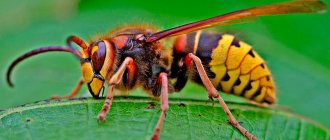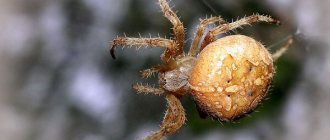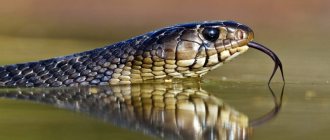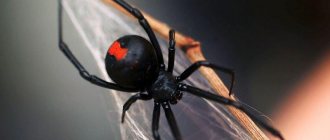The fauna of our planet is full of a huge number of living creatures that fascinate with their diversity, so it is often difficult to immediately determine what species an organism belongs to.
For example, not many people know that spiders belong to animals, a phylum of arthropods and a class of arachnids . There are more than 42 thousand species of spiders, of which 1.1 thousand are fossils.
Moreover, they can be found everywhere, even where no living creature can live. This article will take a detailed look at who spiders are and what they are.
Is a spider an insect or not?
Many people wonder whether a spider actually is an insect or an animal. Most will immediately answer that it is an insect, but this is not the case. Even if in appearance this organism looks like crawling small inhabitants, it is in no way related to them and has distinctive features.
They are animals; among the inhabitants of the fauna they are classified as invertebrates. These are arthropods that have jointed limbs, a hard chitinous cover, which is a hard exoskeleton.
Therefore, the question arises why spiders are not insects and animals. And also interested in what exactly connects mammals, what common features they have with insects and differences from them. This is worth considering carefully.
General signs
The family of spiders and insects share some common characteristics. This is due to the fact that arachnids belong to the class of arthropods.
Order Arthropods
Arthropods are a group that accounts for more than 80% of the planet's living creatures. Their difference is an exoskeleton made of chitin and paired jointed limbs.
The ancestors of arthropods are considered to be either worm-like or tracheal. However, there is an opinion that all representatives came from one ancestor - nematodes.
Representatives of arthropods.
One of the most famous classifications of origin divides them into three types:
- Tracheal;
- Crustaceans;
- Cheliceraceae.
Tracheal
This group of arthropods have respiratory organs, which made them adapted to life on land. The respiratory system has been improved, and the skin has been strengthened.
There are several representatives of this species.
A superclass of invertebrates that has a segmented body. They have a large number of legs and a body that is not divided into sections.
Centipedes
This is a subphylum that includes a wide variety of insects. According to the name, the number of their limbs is six. Lifestyle and nutrition are different.
Hexapods
Crustaceans
This group contains a large number of animals that live in various types of reservoirs. Although there are some species that can live on land or in humid conditions.
They have a chitinous exoskeleton that is periodically shed and their respiratory organs are gills. The group includes:
- crabs;
- lobsters;
- shrimps;
- crayfish;
- krill;
- lobsters.
Cheliceraceae
Cheliceraceae.
The largest part of this subgroup is represented by arachnids. These also include ticks and crustacean scorpions. They have a specific role in nature and for humans.
The subclass got its name from its limbs, chelicerae. These are oral appendages that are divided into two or three segments. But they are not designed for eating tough foods.
Interesting facts about spiders
Unusual facts about spiders will amaze many who do not yet know about these creatures. But they conceal many mysteries, secrets, and have unique features that other organisms living on the globe do not have.
Let's look at 15 interesting facts about spiders:
- The web is not only a trap for insects, it is capable of deflecting several millimeters in order to grab and stick an insect to itself. This phenomenon is carried out due to a static charge, which appears during the flight of the insect.
- The bite of the Brazilian wandering spider is not always fatal, but it often causes impotence in men.
- With the help of its limbs, the spider can determine what has reached it in the web. But edible or inedible helps him establish the olfactory organs, which are located on his legs.
- The animal has a durable shell. Its strength can withstand a nuclear explosion.
- The web is very light. If you take a spider thread the length of the earth's equator, then its weight will be only 340 grams.
- Spider web is considered a powerful and durable material. If its thickness is increased to the thickness of a pencil, then such a web could stop a Boeing. In New Guinea, fishermen use this material to catch fish, and in South America there are spider web bridges that support monkeys.
- The lifespan of arthropods is 30 years. But they rarely die of old age.
- At one time, the female can lay up to 20 thousand eggs, from which spiders hatch.
- In nature, there are varieties of spiders that, after being born, eat their mother.
- There are varieties of arachnids in which the brain occupies the largest part of the body, so other organs are forced to be located on the legs. The smaller the spider, the larger its brain.
- In the Netherlands there are more spiders than people. For 15 million human population there are 5 thousand billion arthropods.
- In Cambodia, people enjoy eating tarantula spiders. They are also brought up at home, they learn to dance, and play willingly. And if necessary, they can protect the owner.
- There are types of spiders that do not weave webs - the jumping spider, the lynx spider. They do not catch prey with webs, but hunt it.
- Tarantulas can live without food for about two years.
- The gladiator got its name due to the fact that it weaves a web in a square. He does not leave her until the prey falls into her; he himself abruptly throws the net on her, thereby leaving no chance to escape.
Nutrition
The main diet consists of insects of different sizes. The spider's trapping nets catch flies, wasps, hornets, grasshoppers, locusts, caterpillars, and butterflies. Snakes, frogs, toads, and mice get entangled in large, strong webs.
Cross spider
There is no internal digestive system, food liquefaction occurs externally. The spider bites the victim, injects poison that paralyzes the muscles and immobilizes the prey. The cross releases saliva into the insect’s body, envelops it in a web, and waits for several minutes. In 5-20 minutes, the insides of the prey turn into a liquid mass, which the predator sucks up.
Interesting Facts
Spiders inspire fear in people, but at the same time they inspire interest. Therefore, they are studied and even raised at home as pets.
Flying spiders There is evidence that some species of spiders can fly. And this is not to instill fear in the impressionable. This method is a protection and a method of movement.
Spiders with a tail There were individuals that had a tail. Unusual tailed spiders and their descendants.
Spider web Spider web is a durable and stable material; it can stretch many times and return to its original position.
Man and Spider
Spiders play a fairly significant role in people's lives:
- arthropods destroy many harmful insects, helping to preserve the yield of agricultural plants;
- in some countries, well-cooked spiders of some species are considered a delicacy;
- scientists are actively studying the properties of spider venom and exploring the possibilities of using it in medicine to treat various diseases, for example, Alzheimer's disease or erectile dysfunction;
- some species are very popular as exotic pets;
- physicists are studying the unique properties of the web and its role in the life of spiders and are trying to create a similar material.
In addition, the unusual appearance and abilities of arthropods have become the reason that spiders often become characters in works of art: comics, books, films.
But the danger of spiders to humans is greatly exaggerated. Indeed, the bite of some poisonous individuals can cause health problems, but very often the person himself provokes an attack. It is extremely rare for spiders to attack people for no reason.
Arachnophobia
Arachnophobia, or fear of spiders, is one of the most common and difficult to treat phobias in the world. People with this disease experience attacks of fear and sometimes panic at the sight of even the smallest and most harmless spider.
Moreover, not only a living person, but also his image can cause negative emotions. Attacks are often accompanied by weakness, dizziness, nausea and increased sweating. Particularly sensitive people faint.
Fun fact: Most patients have never experienced an arachnid attack, so their fears are unfounded.
True representatives of blue bloods
The blood (more correctly called hemolymph) of spiders is rich in copper pigments, giving it a bluish tint. Blood cells play an important role in blood clotting, wound healing, and fighting infections. One molecule of spider hemolymph contains more than 600 amino acids, or protein building blocks.
About 30 species of spiders contain poison that is lethal to humans. Black widows, Australian funnel-web spiders, American browns, two species of European water spiders and the aggressive South American ctenid spiders contain venom that attacks and disturbs the human central nervous system. If bitten, the person must take an antidote to avoid death.
However, in most cases, spider bites are much less dangerous to humans than the poisonous stings of bees, wasps and hornets.
The spider's venom is designed to paralyze its prey - mainly insects. Defensive bites against large animals, including humans, are secondary.
The poison is injected through the fangs. The spider crunches its prey either immediately after wrapping it in silk, or sucks out its innards through holes in its fangs - like a straw draining the last drop from a soda bottle.
Features of reproduction
During the process of active growth, spiders from time to time shed their tight shell, which consists of a chitinous structure. They gradually acquire a new, stronger one.
Over the entire period of their life, they can molt up to 10 times . Spiders are heterosexual individuals, with the female being much larger than the male.
The mating period lasts quite a long time, its season begins in mid-autumn and lasts until early spring. At this time, the male fills the bulbs, which are located at the ends of the pedipalps, with sperm, then he goes in search of the female.
After performing the “mating dance” and fertilization, the male leaves and dies in the subsequent period.
As soon as 2.5 months have passed, the female lays eggs. After 35 days, spiderlings hatch from them and live in the web until the first molt. Sexual maturity in females occurs at the age of 3-5 years.
Insects and spiders
These two types of arthropods are often confused. But they have much more differences than they have in common. Among insects, there are those that eat meat and those that are vegetarians. Spiders are mostly predators.
Spiders are definitely not insects! More differences in the structure and behavior of insects and spiders in the article at the link.
Spider Anatomy
Spider eyes The number of eyes is not an indicator of good vision. And spiders are a prime example of this.
Spider legsThe limbs perform not only a walking role. They help in hunting.
Spider reproductionThe method of reproduction of spiders is determined by their lifestyle and structural features.
Is a spider an insect or not? Why is a spider not an insect?
Spiders, especially small ones, are similar in appearance to insects, but are not insects. But why is a spider not an insect?
Insects and arachnids are divided into two different classes, which belong to the same phylum of animals - arthropods. They have some similarities in structure, but there are many more differences. Family connections are revealed by the chitinous cover and some details of the body structure: the chest and abdomen are connected by a thin stalk, legs are located in pairs on the sides of the chest. Only an insect has six legs, and a spider has eight. In addition, the spider has chelicerae - small limbs with poisonous claws located next to the mouthparts.
The front part of the body is also different: in insects the movable head is separated from the chest; in arachnids there is not even any semblance of a “neck”; the head is combined with the chest into one part of the body, which is called the cephalothorax.
Black widow (Latrodectus mactans)
Insects have two eyes with a complex structure, spiders have much more primitive eyes, but there are eight of them. There are spiders with six eyes and rarely with two.
Insects are carnivores and vegetarians. The former eat their food with powerful jaws and literally chew their food; the latter mainly feed on nectar using “proboscis”. The feeding of spiders is radically different - they inject gastric juice into their prey, wait until the soft tissues soften and then suck up the nutritious “soup” through a narrow mouth slit, devoid of teeth, lips and, in general, any signs of the oral apparatus familiar to us. Almost all spiders are predators; only one species has been found that feeds on plants - Kipling's bagheera spider.
The head of all types of insects is decorated with a pair of antennae; spiders do not have these antennae.
Another striking difference is the web. Spiders have three pairs of arachnoid warts that release a thin stream of sticky liquid, which hardens after a few seconds without losing its stickiness. A spider's web is a trap for insects that do not know how to create such deadly laces.
By the way, the spider is much more closely related than insects to scorpions and mites, which also belong to the class of arachnids.
Arachnophobia is a special case of zoophobia, fear of arthropods (mainly arachnids), and is one of the most common phobias. Moreover, for some people, it is not even the spider itself that can cause much greater fear, but the image of the spider.
Internal structure
Digestive system
The spider's digestive system consists of the mouth, pharynx, esophagus, stomach, and intestines (front, middle and back). In the midgut, long blind processes increase its volume and absorption surface.
Undigested residues are expelled through the anus. The spider cannot eat solid food. Having caught prey (some insect) with the help of a web, he kills it with poison and lets digestive juices into his body. Under their influence, the contents of the captured insect liquefy, and the spider sucks it up. All that remains of the victim is an empty chitinous shell. This method of digestion is called extraintestinal.
Circulatory system
The spider's circulatory system is not closed. The heart looks like a long tube located on the dorsal side of the abdomen.
Blood vessels extend from the heart.
In a spider, the body cavity is of a mixed nature - during development it arises from the connection of the primary and secondary body cavities. Hemolymph circulates in the body.
Respiratory system
The spider's respiratory organs are the lungs and trachea. The lungs, or pulmonary sacs, are located below, in the front of the abdomen. These lungs developed from the gills of the distant ancestors of spiders that lived in water.
The cross spider has two pairs of non-branching tracheas - long tubes that deliver oxygen to organs and tissues. They are located in the back of the abdomen.
The spider's nervous system consists of the cephalothoracic nerve ganglion and numerous nerves extending from it.
Excretory system
The excretory system is represented by two long tubes - Malpighian vessels. One end of the Malpighian vessels ends blindly in the body of the spider, the other opens into the hind intestine. Harmful waste products come out through the walls of the Malpighian vessels, which are then excreted. Water is absorbed in the intestines. In this way, spiders conserve water so they can live in dry places.











